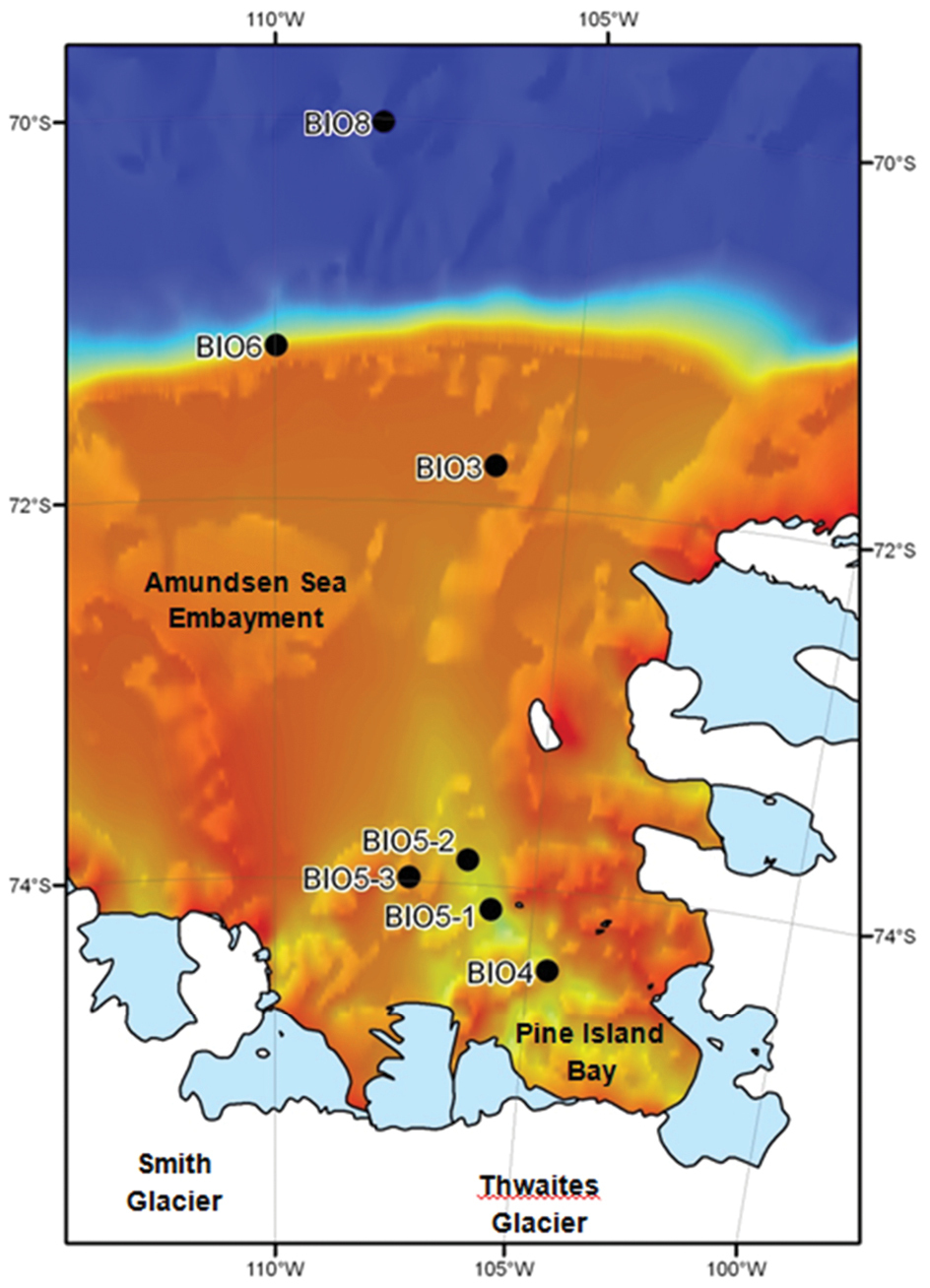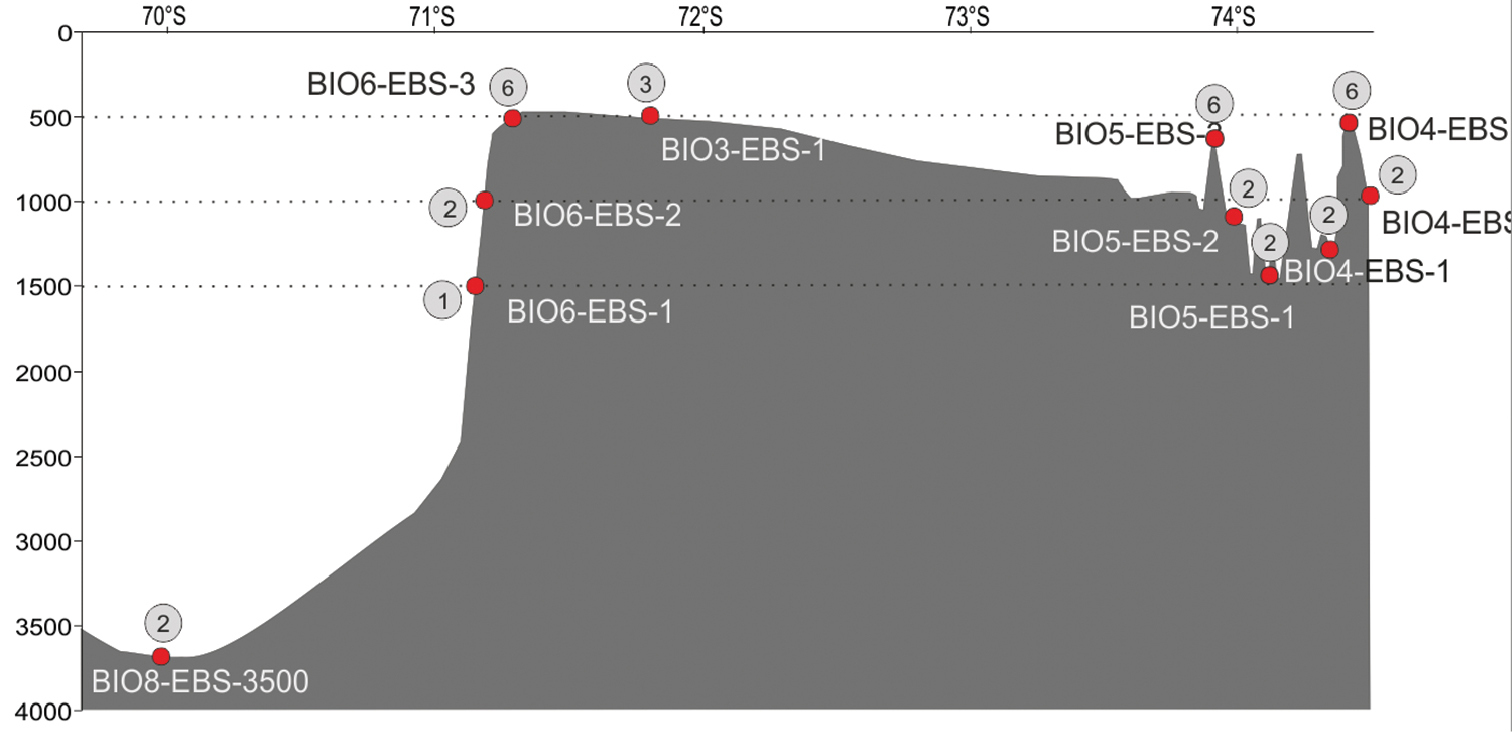






(C) 2013 Camille Moreau. This is an open access article distributed under the terms of the Creative Commons Attribution License 3.0 (CC-BY), which permits unrestricted use, distribution, and reproduction in any medium, provided the original author and source are credited.
For reference, use of the paginated PDF or printed version of this article is recommended.
Information regarding the molluscs in this dataset is based on the epibenthic sledge (EBS) samples collected during the cruise BIOPEARL II / JR179 RRS James Clark Ross in the austral summer 2008. A total of 35 epibenthic sledge deployments have been performed at five locations in the Amundsen Sea at Pine Island Bay (PIB) and the Amundsen Sea Embayment (ASE) at depths ranging from 476 to 3501m. This presents a unique and important collection for the Antarctic benthic biodiversity assessment as the Amundsen Sea remains one of the least known regions in Antarctica. Indeed the work presented in this dataset is based on the first benthic samples collected with an EBS in the Amundsen Sea. However we assume that the data represented are an underestimation of the real fauna present in the Amundsen Sea. In total 9261 specimens belonging to 6 classes 55 families and 97 morphospecies were collected. The species richness per station varied between 6 and 43. Gastropoda were most species rich 50 species followed by Bivalvia (37), Aplacophora (5), Scaphopoda (3) and one from each of Polyplacophora and Monoplacophora.
Mollusca, Antarctica, Amundsen Sea, Bivalvia, Gastropoda, Scaphopoda, Aplacophora, Monoplacophora, Polyplacophora, BIOPEARL II
Project title: BIOPEARL II-JR 179 RRS James Clark Ross 2008
Personnel: Camille Moreau, Katrin Linse, Huw Griffiths, Peter Enderlein and David Barnes
Funding: This study is part of the British Antarctic Survey Polar Science for Planet Earth Programme funded by the Natural Environment Research Council.
Study extent description: The study area of this dataset was set in the eastern Amundsen Sea and focused on the continental shelf, upper slope and over-deepened shelf basins of the Amundsen Sea Embayment (ASE) and Pine Island Bay (PIB). This dataset presents species occurrences and species richness of the individual epibenthic sledge (EBS) deployments. PIB appears to be the third largest drainage outlet of the West Antarctic Ice Sheet (
Design description: The Amundsen Sea is a very under sampled area on the Antarctic continental shelf, according to a recent gap analysis carried out by Griffiths et al. (2011). BIOPEARL (Biodiversity dynamics : phylogeography, evolution and radiation of life in Antarctica), a core project at the British Antarctic Survey, studied the southern Bellingshausen and eastern Amundsen seas to assess the biodiversity at local and regional scales (comparable to the BIOPEARL 2006 cruise to the Scotia Sea) and investigate the phylogenetic relationships of selected marine invertebrate taxa and their biogeography in reference to the climatological, oceanographical and geological history of the Bellingshausen/Amundsen Seas. The results are used to determine of the role of Antarctica and extreme environments in general in evolutionary innovation and generation of global biodiversity. The species presence data are added to SOMBASE (Southern Ocean Mollusc Database www.antarctica.ac.uk/sombase). SOMBASE generated initial core data system upon which SCAR’s Marine Biodiversity Information Network (SCAR-MarBIN) was built. As SCAR-MarBIN is the Antarctic Node of the international OBIS network, the SOMBASE data system was designed to comply with the Darwin Core standards. Regarding the dataset, the existing Data Toolkit from SCAR-MarBIN was used (http://www.scarmarbin.be/documents/SM-FATv1.zip), following the OBIS schema (http://iobis.org/data/schema-and-metadata). The dataset was uploaded in the ANTOBIS database (the geospatial component of SCAR-MarBIN), and the taxonomy was matched against the Register of Antarctic Marine Species, using the Taxon Match tool (http://www.scarmarbin.be/rams.php?p=match). The dataset meets the Darwin Core requirements and was designed around this data schema.
Sampling description: Five locations in the Pine Island Bay (PIB) and Amundsen Sea Embayment (ASE) at different depths ranging from 476 to 3501m have been sampled using an epibenthic sledge (EBS). Most deployments were made along depth transects from shallow to overdeepened continental shelf and to deeper slope (Figure 1 and 2). At three of the five locations samples were taken at ~500m, ~1000m and ~ 1500m depths, due to the particular geomorphology (presence of deep troughs close to the continent) of the ASE continental plateau. At each site, replicates (individual stations) were taken to assess habitat homogeneity and their number depended on water depth; three to six replicates were taken at 500m and two at 1000m, 1500m and 3500m depth. The BIOPEARL II cruise report is available from the British Oceanographic Data Centre (https://www.bodc.ac.uk/data/information_and_inventories/cruise_inventory/report/8277/).
BIOPEARL II EBS stations in the Amundsen Sea and its seafloor topography. The bathymetry colour legend goes from 200m (red) to 4000m (dark blue).
BIOPEARL II station and number of replicates reported on the seafloor topography of the Amundsen Sea Embayment.
This dataset presents 34 EBS deployments: 21 of which were performed at a depth of 500m at four different sites (BIO3-1, BIO4-3, BIO5-3 and BIO6-3) , six at a 1000m depth in three areas (BIO4-2, BIO5-2 and BIO6-2), five at a depth of 1500m at three different sites (BIO4-1, BIO5-1 and BIO6-1), and two replicates at site BIO8-3500 in 3500m depth. For three of the five locations, sites were positioned along vertical transects sampling at 500m, 1000m and 1500m with repeat deployments of the EBS. The sites BIO4-1, BIO4-2 and BIO4-3 and BIO6-1, BIO6-2 and BIO6-3 were situated in the same local area; while the sites BIO5-1, BIO5-2 and BIO5-3 were dispersed over a wider area because of ice cover. The EBS consist of on an epi-(below) and a supra-(above) net. Each of these nets has a mesh size of 500μm and an opening of 100x33cm. The cod end of both nets is equipped with net-buckets containing a 300μm mesh window (
Quality control description: A species name was given to each specimen when it was possible. Individuals not corresponding to described species have been included in the analyses with the family or genus name and a letter or numerical code (e.g. Turbinidae gen. sp.), however they represent a single morphospecies.
For these specimens, further morphological and genetic analyses are necessary to give them a species name but they can be included in this dataset as different species. Finally, specimens too badly damaged for species identification have not been taken in account here.
This dataset presents species occurrences and species richness of the individual EBS deployments.
General taxonomic coverage description: The present dataset focus on six molluscs classes (Mollusca: Aplacophora, Monoplacophora, Polyplacophora, Gastropoda, Bivalvia & Scaphopoda). It includes respectively for each class:
Class: Aplacophora
Species: Aplacophora sp. 1, Aplacophora sp. 2, Aplacophora sp. 3, Aplacophora sp. 4, Aplacophora sp. 5
Class: Polyplacophora
Family: Leptochitonidae
Genus: Leptochiton
Species: Leptochiton sp.
Class: Monoplacophora
Family: Micropilinidae
Genus: Micropilina
Species: Micropilina sp.
Class: Gastropoda
Family: Scissurellidae, Ataphridae, Mangeliidae, Capulidae, Calliotropidae, Seguenzioidea, Turbinidae, Turridae, Eulimidae, Limacinidae, Eatoniellidae, Cancellarioidea, Naticidae, Rissoidae, Diaphinidae, Fissurellidae, Raphitomidae, Cylichnidae, Lepetidae, Orbitestellidae, Buccinidae, Mathildidae, Newtoniellidae, Marginellidae, Cavoloniidae
Genus: Anatoma, Trochaclis, Lorabela, Belalora, Torellia, Capulus, Calliotropis, Brookula, Brookula, Lissotesta, Liotella, Cirsonella, Balcis, Onoba, Hemiaclis, Limacina, Eatoniella, Cancellaridae gen., Falsilunatia, Pseudomauropsis, Sinuber, Powellisetia, Rissoid, Toledonia, Fissurellidae gen., Cornisepta, Zeidora, Pleurotomella, Cylichna, Iothia, Microdiscula, Pareuthria, Turritellopsis, Cerithiella, Eumetula, Marginella, Clio
Species: Anatoma euglypta, Trochaclis antarctica, Lorabela pelseneeri, Belalora cf striatula, Torellia insignis, Capulus sp., Calliotropis pelseneeri, Brookula cf charleenae, Brookula sp. b, Lissotesta sp., Liotella sp., Liotella cf endeavourensis, Cirsonella extrema, Turbinid sp. Turrid sp. 1, Turrid sp. 2, Balcis sp. Onoba cf gelida, Hemiaclis incolorata, Limacina helicina, Eatoniella cf kerguelenensis regularis, Cancellarid sp. Falsilunatia sp. Pseudomauropsis anderssoni, Sinuber microstriatum, Powellisetia cf deserta, Rissoid sp. Toledonia sp. 1, Toledonia sp. 2, Toledonia cf elata, Fissurellidae gen. sp. 1, Fisserulidae gen. sp. 2, Cornisepta antarctica, Zeidora antarctica, Pleurotomella cf simillima, Cylichna sp. Iothia sp. Microdiscula sp. Pareuthria cf innocens, Turritellopsis gratissima, Cerithiella cf lineata, Cerithiella cf erecta, Eumetula cf strebeli, Marginella ealesae, Clio antarctica
Class: Bivalvia
Family: Nuculanidae, Nuculidae, Yoldiidae, Limopsidae, Philobryidae, Mytilidae, Limidae, Pectinidae, Propeamussiidae, Thyasiridae, Motacutidae, Lasaeidae, Cyamiidae, Carditidae, Thraciidae, Cuspidariidae, Lyonsiidae, Poromyidae, Neoleptonidae, Siliculidae, Arcidae, Vesicomyidae, Tindariidae, Bathyspinulidae
Genus: Propeleda, Ennucula, Yoldiella, Limopsis, Philobrya, Adacnarca, Dacrydium, Limatula, Adamussium, Hyalopecten, Cyclochlamys, Thyasira, Mysella, Waldo, Cyamiocardium, Cyclocardia, Thracia, Cuspidaria, Myonera, Lyonsia, Poromya, Neolepton, Silicula, Bathyarca, Vesicomya, Tindaria, Bathyspinula
Species: Propeleda longicaudata, Ennucula sp. Yoldiella ecaudata, Yoldiella sabrina, Yoldiella valettei, Yoldiella cf profundorum, Yoldiella oblonga, Yoldiella sp. Limopsis longipilosa, Limopsis knudseni, Philobrya sublaevis, Philobrya quadrata, Adacnarca nitens, Dacrydium albidum, Limatula Limatula sp. Limatula Antarctolima sp. Adamussium colbecki, Hyalopecten pudicus, Cyclochlamys pteriola, Cyclochlamys gaussiana, Thyasira sp. Mysella antarctica, Waldo sp. Cyamiocardium denticulatum, Cyclocardia astartoides, Thracia meridionalis, Cuspidaria infelix, Cuspidaria minima, Myonera fragilissima, Lyonsia arcaeformis, Poromya antarctica, Neolepton sp. Silicula rouchi, Bathyarca sinuata, Vesicomya sirenkoi, Tindaria sp. Bathyspinula sp.
Class: Scaphopoda
Family: Dentaliidae, Pulsellidae, Gadilidae
Genus: Dentalium, Striopulsellum, Cadulus
Species: Dentalium majorinum, Striopulsellum minimum, Cadulus thielei
General spatial coverage: Amundsen Sea, Antarctica
Coordinates: 74°29'24"S and 70°1'12"S; 110°5'24"W and 104°20'24"W
Temporal coverage: February 18, 2008–April 11, 2008
Natural collections description
Parent collection identifier: British Antarctic Survey
Collection name: BIOPEARL II EBS Molluscs
Collection identifier: Moreau/Linse
Specimen preservation method: Ethanol/Formaldehyde
- Epibenthic sledge sampling in the Amundsen Sea
- Once on the deck, the content of the samplers from the first deployment was immediately fixed in 96% undenaturated and pre-cooled (at -20°C) ethanol (
- The taxonomic identification was performed in the British Antarctic Survey laboratory using a stereomicroscope.
Object name: Darwin Core Archive amundsen_sea_molluscs
Character encoding: UTF-8
Format name: Darwin Core Archive format
Format version: 1.0
Distribution: http://ipt.biodiversity.aq/archive.do?r=amundsenseamolluscs_biopearl_ii
Publication date of data: 2013-01-09
Language: English
Metadata language: English
Date of metadata creation: 2013-01-09
Hierarchy level: Dataset

